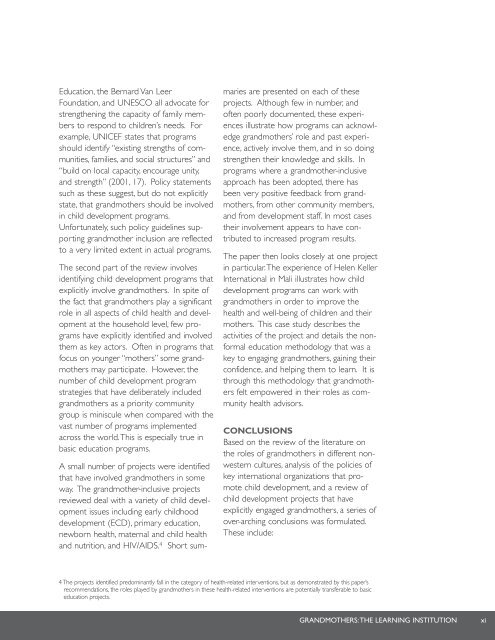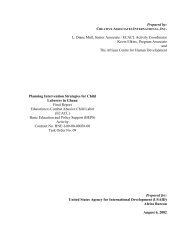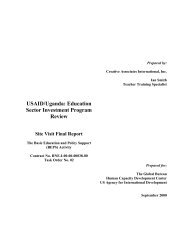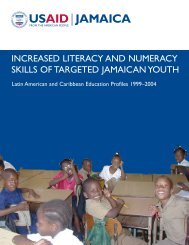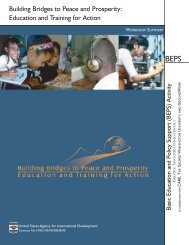Grandmothers: A Learning Institution - Basic Education and Policy ...
Grandmothers: A Learning Institution - Basic Education and Policy ...
Grandmothers: A Learning Institution - Basic Education and Policy ...
- No tags were found...
Create successful ePaper yourself
Turn your PDF publications into a flip-book with our unique Google optimized e-Paper software.
<strong>Education</strong>, the Bernard Van LeerFoundation, <strong>and</strong> UNESCO all advocate forstrengthening the capacity of family membersto respond to children’s needs. Forexample, UNICEF states that programsshould identify “existing strengths of communities,families, <strong>and</strong> social structures” <strong>and</strong>“build on local capacity, encourage unity,<strong>and</strong> strength” (2001, 17). <strong>Policy</strong> statementssuch as these suggest, but do not explicitlystate, that gr<strong>and</strong>mothers should be involvedin child development programs.Unfortunately, such policy guidelines supportinggr<strong>and</strong>mother inclusion are reflectedto a very limited extent in actual programs.The second part of the review involvesidentifying child development programs thatexplicitly involve gr<strong>and</strong>mothers. In spite ofthe fact that gr<strong>and</strong>mothers play a significantrole in all aspects of child health <strong>and</strong> developmentat the household level, few programshave explicitly identified <strong>and</strong> involvedthem as key actors. Often in programs thatfocus on younger “mothers” some gr<strong>and</strong>mothersmay participate. However, thenumber of child development programstrategies that have deliberately includedgr<strong>and</strong>mothers as a priority communitygroup is miniscule when compared with thevast number of programs implementedacross the world.This is especially true inbasic education programs.A small number of projects were identifiedthat have involved gr<strong>and</strong>mothers in someway. The gr<strong>and</strong>mother-inclusive projectsreviewed deal with a variety of child developmentissues including early childhooddevelopment (ECD), primary education,newborn health, maternal <strong>and</strong> child health<strong>and</strong> nutrition, <strong>and</strong> HIV/AIDS. 4 Short summariesare presented on each of theseprojects. Although few in number, <strong>and</strong>often poorly documented, these experiencesillustrate how programs can acknowledgegr<strong>and</strong>mothers’ role <strong>and</strong> past experience,actively involve them, <strong>and</strong> in so doingstrengthen their knowledge <strong>and</strong> skills. Inprograms where a gr<strong>and</strong>mother-inclusiveapproach has been adopted, there hasbeen very positive feedback from gr<strong>and</strong>mothers,from other community members,<strong>and</strong> from development staff. In most casestheir involvement appears to have contributedto increased program results.The paper then looks closely at one projectin particular.The experience of Helen KellerInternational in Mali illustrates how childdevelopment programs can work withgr<strong>and</strong>mothers in order to improve thehealth <strong>and</strong> well-being of children <strong>and</strong> theirmothers. This case study describes theactivities of the project <strong>and</strong> details the nonformaleducation methodology that was akey to engaging gr<strong>and</strong>mothers, gaining theirconfidence, <strong>and</strong> helping them to learn. It isthrough this methodology that gr<strong>and</strong>mothersfelt empowered in their roles as communityhealth advisors.CONCLUSIONSBased on the review of the literature onthe roles of gr<strong>and</strong>mothers in different nonwesterncultures, analysis of the policies ofkey international organizations that promotechild development, <strong>and</strong> a review ofchild development projects that haveexplicitly engaged gr<strong>and</strong>mothers, a series ofover-arching conclusions was formulated.These include:4 The projects identified predominantly fall in the category of health-related interventions, but as demonstrated by this paper’srecommendations, the roles played by gr<strong>and</strong>mothers in these health-related interventions are potentially transferable to basiceducation projects.GRANDMOTHERS:THE LEARNING INSTITUTIONxi


